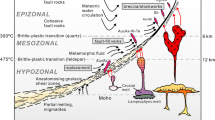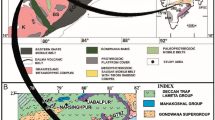Abstract.
The Carlin-type gold deposits in China lie mostly near the margins of the Proterozoic Yangtze and Aba cratons. Submicron-sized gold in micron-sized arsenian pyrite is disseminated in fractured Cambrian through Triassic carbonaceous shale and carbonate rocks, and is associated with anomalous Hg, Sb, As, U, and Tl. Alteration typically includes silicification, argillization, and sulfidation. Aqueous fluid inclusions contain CO2, have relatively low temperatures of homogenization (250–150 °C), and salinities (8–2 wt% equiv. NaCl) that typically decrease from early to later stages. The indicated pressures of 105–330×105 Pa correspond to depths in excess of 1.0 to 3.0 km, assuming hydrostatic conditions. The δD values of fluid inclusions (–87 to –47‰) and the calculated δ18O values for water in ore fluids (–2.1 to 16.2‰) reflect interactions between meteoric water and sedimentary rocks. The δ13C values of calcite (–9 to 2‰) and δ34S values of sulfides (–24 to 17‰) suggest that C and S were derived from marine carbonate (and organic carbon) and diagenetic sulfides (and organic sulfur) in the vicinity of the deposits. Geologic relationships and geochronologic evidence indicate the deposits formed during a late phase of the Yanshanian orogeny (140–75 Ma).
These gold deposits share much in common with the Carlin-type gold deposits in Nevada, USA. Both occur in carbonaceous, pyritic, sedimentary rocks deposited on extended margins of Precambrian cratons. The smaller Chinese deposits are generally in more siliceous rocks and the larger Nevada deposits in more calcareous rocks. In both countries, the host rocks prior to mineralization were affected by contractional deformation that produced many of the ore-controlling structures and the deposits do not show consistent spatial or genetic relationships with epizonal plutons. However, the Nevada deposits show broad spatial and temporal relationships with shifting patterns of calc-alkaline magmatism. The ore and alteration mineral assemblages, residence of gold, geochemical signatures, paragenetic sequence, and fluid inclusions are remarkably similar, which indicates that the deposits formed from low salinity, moderately acidic, CO2- and H2S-rich fluids by similar processes at relatively shallow levels in the crust (<5 km). However, the deposits in China are associated with large Hg, Sb, As, U, and Tl deposits, which may reflect higher background abundances of these elements. Stable isotopic data suggest meteoric water evolved to become ore fluids through interactions with sedimentary rocks, although contributions of volatiles or metals from deeper levels are present in some deposits in Nevada. In both countries, the deposits appear to have formed in an area of high paleothermal gradients after a change in stress regime during the later phases of orogenic activity.
Similar content being viewed by others
Author information
Authors and Affiliations
Additional information
Electronic Publication
Rights and permissions
About this article
Cite this article
Rui-Zhong, H., Wen-Chao, S., Xian-Wu, B. et al. Geology and geochemistry of Carlin-type gold deposits in China. Min Dep 37, 378–392 (2002). https://doi.org/10.1007/s00126-001-0242-7
Received:
Accepted:
Issue Date:
DOI: https://doi.org/10.1007/s00126-001-0242-7




